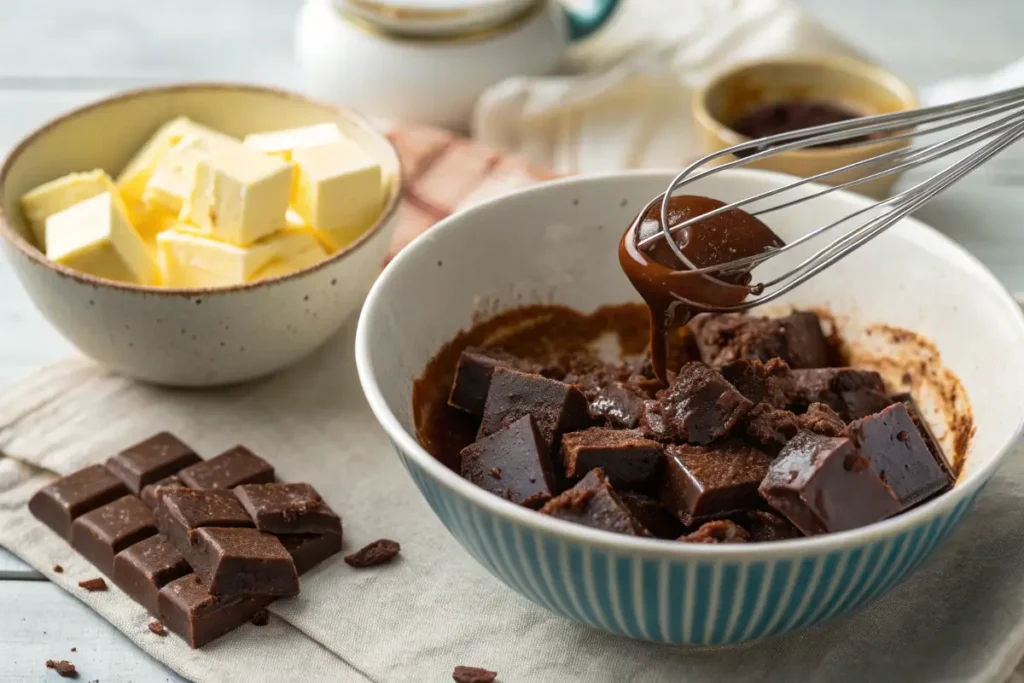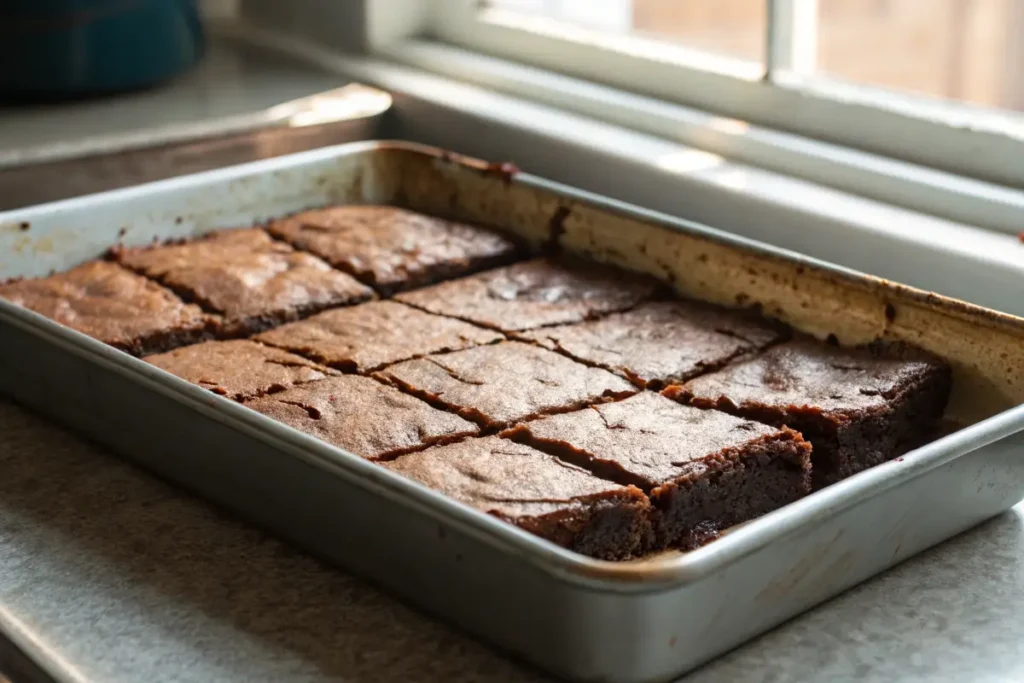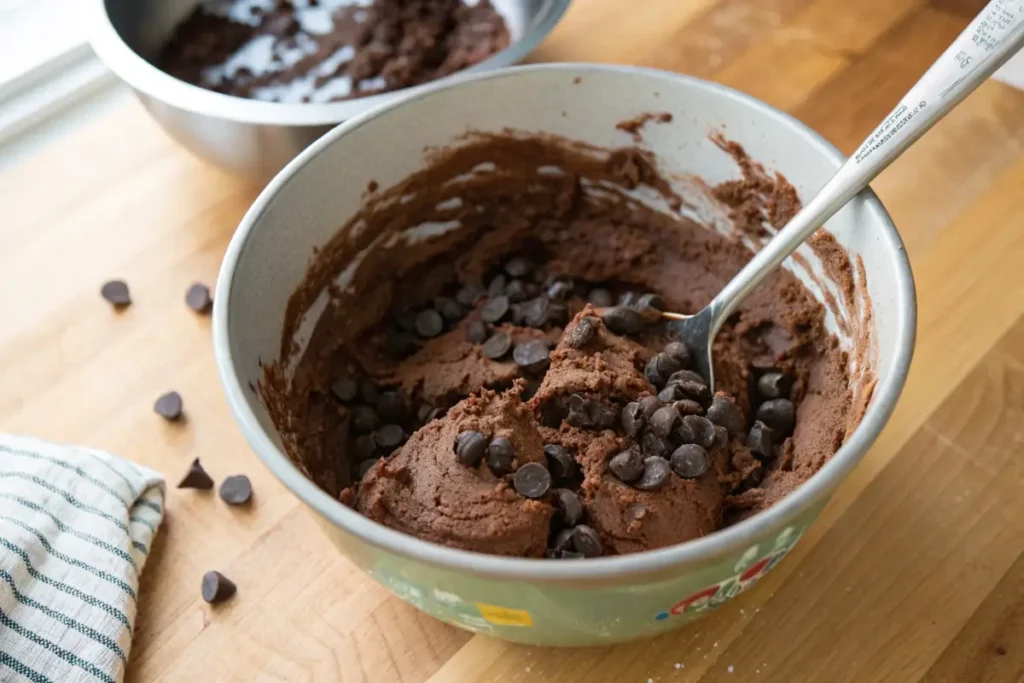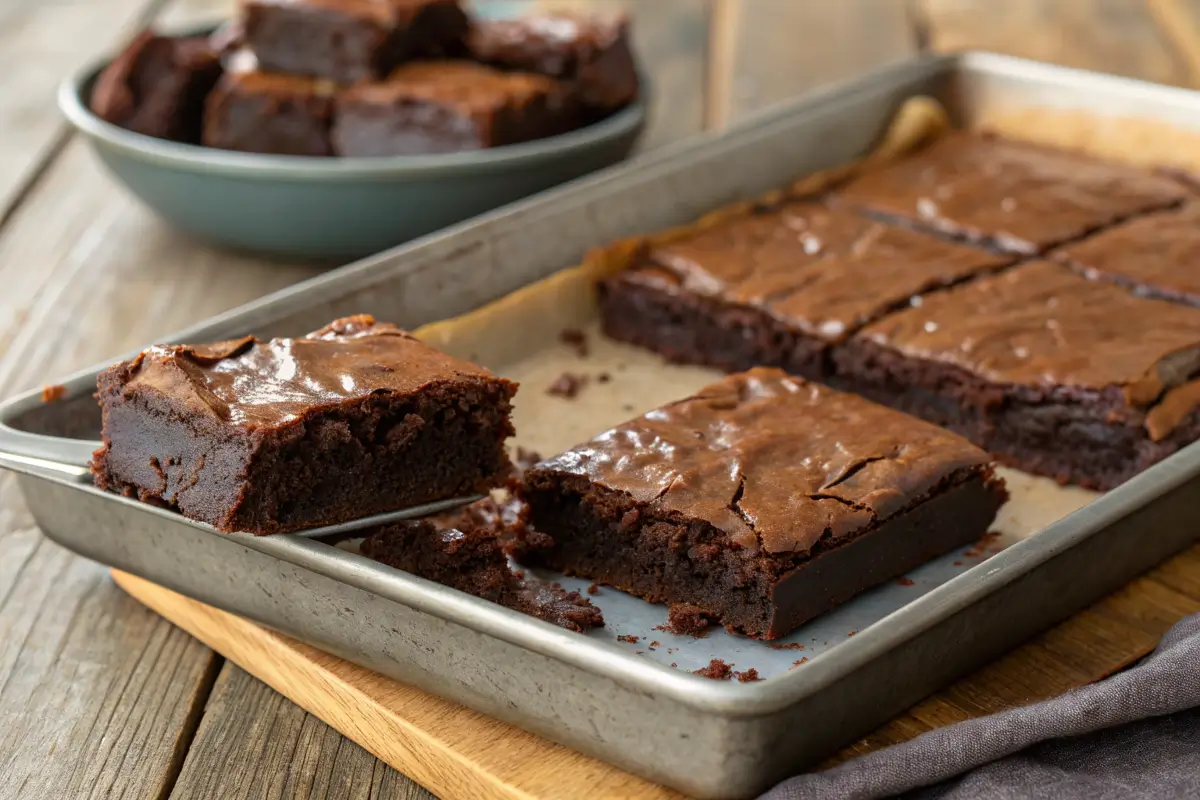Introduction:
Brownies are a beloved dessert, but there’s a world of difference between a cakey brownie and a fudgy brownie. While some prefer the light and airy texture of a cake-like brownie, others crave that rich, gooey, and dense bite that comes from a truly fudgy treat. If you’ve ever wondered, what makes brownies more fudgy?—this article is for you. We’ll dive deep into the science of fudgy brownies, exploring the key ingredients, techniques, and even some common mistakes that might be keeping your brownies from achieving that perfect, fudgy texture. Let’s get started with the basics before moving into the finer details!
Introduction to Fudgy Brownies
What Does “Fudgy” Mean in Brownies?
When it comes to brownies, fudgy refers to a dense, moist, and slightly gooey texture that feels rich and decadent with every bite. Fudgy brownies are the ones that give you that satisfying melt-in-your-mouth feeling, and unlike their cake-like counterparts, they don’t leave you with a dry or airy aftertaste. The key difference lies in the moisture content and the fat-to-flour ratio, which determines how dense and chewy your brownies will be.
But what makes brownies fudgy in the first place? It’s a combination of ingredients, baking techniques, and the right balance between fat and liquid. Butter, chocolate, and sugar play a crucial role in creating the rich texture that defines fudgy brownies. This is a stark contrast to cake-like brownies, where more flour and less fat give them a fluffier texture. So, if you’re wondering what the fuss is about fudgy brownies, it’s all about that creamy, decadent texture that makes each bite feel like a dream.
Difference Between Fudgy and Cake-like Brownies
At first glance, you might think that all brownies are the same. But when you cut into them, the difference between fudgy and cake-like brownies is immediately apparent. Fudgy brownies are moist, dense, and hold their shape when you cut them. On the other hand, cake-like brownies have a lighter, airier consistency, and often have a crumbly texture. The key factor that sets them apart is the ratio of ingredients—while fudgy brownies typically have more fat (butter and chocolate), cake-like brownies rely more on flour and less on fat, resulting in a fluffier texture.
In the next sections, we’ll explore how ingredients and baking techniques influence the texture of brownies. Stay tuned to find out how you can master the art of fudgy brownies with simple yet effective adjustments.
Key Ingredients That Make Brownies Fudgy

When it comes to making brownies more fudgy, the ingredients you choose—and how they interact—play a significant role. In this section, we’ll explore the key ingredients that can turn a simple brownie recipe into something wonderfully moist, dense, and decadent. Understanding how each ingredient contributes to that perfect fudgy texture will help you bake brownies that are rich and satisfying.
The Role of Butter in Fudgy Brownies
Butter is one of the most important ingredients in creating a fudgy brownie. The high fat content in butter adds moisture, richness, and helps give the brownies a dense texture. Unlike oil, which can sometimes make brownies a bit greasy, butter gives a velvety richness that contributes to the fudgy texture. When baking, the butter melts into the batter, creating pockets of moisture that keep the brownies soft and gooey. For the best fudgy brownies, consider using unsalted butter to maintain control over the flavor profile.
Moreover, butter’s melting point is lower than that of chocolate, so when you combine the two, it results in a smoother batter that bakes into a dense, fudgy texture. Using butter in the right ratio with the other ingredients will ensure that your brownies don’t dry out, a common issue with cakier versions.
Why More Chocolate Equals a Fudgier Texture
Chocolate is another major ingredient when it comes to achieving that rich, fudgy brownie texture. The higher the percentage of cocoa in your chocolate, the more dense and rich the final product will be. Dark chocolate, in particular, brings in extra fat, which is essential for that fudgy consistency. You can also melt some of the chocolate into the batter for added richness, or simply use chocolate chips for that extra burst of fudgy goodness.
It’s important to note that the type of chocolate you use also plays a role. The more chocolate in your recipe (as opposed to cocoa powder), the more likely your brownies will turn out moist and dense. So, if you’ve been wondering what makes brownies more fudgy, increasing the chocolate content is one surefire way to elevate your recipe.
The Importance of Eggs in Achieving Fudgy Brownies
Eggs are not just for binding ingredients together—they also play a key role in creating the perfect fudgy texture in brownies. Understanding how eggs affect the structure of your brownies can help you perfect your recipe.
How Eggs Contribute to the Fudgy Texture
Eggs work as a binding agent, helping the ingredients stick together and form a smooth batter. However, eggs also contribute to the richness of brownies by adding fat and moisture, which are both crucial for achieving that fudgy consistency. The yolk in particular is packed with fat, which helps give the brownies their characteristic dense and moist texture.
Additionally, eggs help with the emulsification process during mixing, allowing the fat (butter and chocolate) to blend seamlessly with the other ingredients, contributing to the smooth, fudgy texture. The more eggs you use, the richer and denser the texture of your brownies will be. A simple trick to achieving extra fudgy brownies is using an additional egg or even an extra yolk, which will add more fat and moisture.
The Best Egg Ratios for Fudgy Brownies
While most brownie recipes call for two eggs, increasing the number to three or more can help elevate the fudgy texture. More eggs provide extra moisture and fat, which contributes to a dense, rich consistency. However, be cautious not to overdo it, as too many eggs can make the brownies overly gooey and cause them to fall apart easily. The ideal egg-to-flour ratio is key to striking that perfect balance of fudgy density without making the brownies too runny.
Incorporating the right amount of eggs can mean the difference between a brownie that’s too dry or one that has that signature fudgy texture everyone craves.
The Science Behind Fudgy Brownies
Understanding the science of what makes brownies more fudgy helps to pinpoint the exact reasons why some brownies end up rich and gooey, while others feel light and crumbly. In this section, we’ll delve into how fat, moisture, and the right baking techniques combine to create the perfect fudgy brownie.

How Fat Content Influences Fudginess
Fat plays a crucial role in making brownies fudgy. The key to fudgy brownies is the right balance of fat—this includes the butter, chocolate, and even eggs. The more fat you use, the denser and more moist the final product becomes. When fat is incorporated into the brownie batter, it helps create a smooth, rich texture that makes each bite feel indulgent.
Butter, in particular, has a low melting point, which means it melts faster during baking, resulting in a denser texture. Using a high-fat chocolate, such as semi-sweet or dark chocolate, can further enhance this effect, increasing the richness of the batter. This combination of ingredients ensures that the brownies will have that delicious fudgy texture instead of being dry or cakey.
Moisture Retention and Fudgy Texture
Another key element in creating fudgy brownies is moisture. Brownies that are too dry won’t have that gooey texture everyone loves. The secret to achieving moist brownies is to retain enough moisture throughout the baking process. Ingredients like butter, eggs, and chocolate contribute to this moisture retention.
One common mistake when baking brownies is overcooking them. If brownies are baked for too long, the moisture escapes, leaving them dry and crumbly. To ensure your brownies stay fudgy, it’s important to bake them at the right temperature and for the right amount of time. Keeping the baking time a bit shorter can help lock in that moisture, ensuring a dense, fudgy texture.
Techniques for Baking Fudgy Brownies
While the right ingredients are essential, what makes brownies more fudgy also depends on the techniques you use during baking. From the type of pan you use to the precise temperature at which you bake, these factors all play a role in creating that gooey, dense brownie texture.
Choosing the Right Pan for Fudgy Brownies
The pan you choose can have a significant impact on the outcome of your brownies. For fudgy brownies, a metal pan is often the best option because it distributes heat more evenly than glass or ceramic. The thinner the pan, the faster the batter bakes, which helps prevent the brownies from becoming too dry. Opt for a 9×9-inch metal pan to create the perfect balance between crisp edges and fudgy centers.
Using a dark-colored pan can also contribute to a fudgier texture, as dark pans absorb more heat, ensuring that the brownies cook evenly. Be sure to line the pan with parchment paper for easy removal and clean-up.
Optimal Baking Time and Temperature for Fudginess
The baking time and temperature are essential when making fudgy brownies. For the best results, bake your brownies at a temperature of 325°F (163°C). Baking at a lower temperature allows the brownies to cook more evenly and slowly, which helps prevent them from becoming too dry.
Overbaking is a common mistake when trying to achieve a fudgy texture. The key is to undercook your brownies slightly, as they will continue to set once removed from the oven. When baking, check for doneness by inserting a toothpick into the center—if it comes out with just a few moist crumbs, your brownies are perfectly fudgy. Let them cool before slicing to allow them to firm up a bit.
Mixing Tips to Keep Brownies Dense and Fudgy

How you mix your brownie batter also plays a role in the final texture. Overmixing the batter can introduce too much air into the mix, leading to cakier brownies. To keep your brownies dense and fudgy, mix the ingredients just until they’re combined—don’t overdo it! Use a spatula or spoon to fold the dry ingredients into the wet ingredients carefully, ensuring a smooth batter without overworking it.
If you want to enhance the fudginess even more, consider using a hand whisk instead of an electric mixer. This method will prevent the over-aeration of the batter and help retain that rich, dense texture.
Fudgy Brownie Variations and Add-ins
While classic fudgy brownies are delicious on their own, there are endless ways to add extra flair to make them even more exciting. Whether you’re looking for flavor variety or extra texture, there are plenty of ways to enhance the fudgy goodness of your brownies. Let’s explore some fun and easy ways to add different ingredients to take your fudgy brownies to the next level.
Adding Nuts or Chips to Fudgy Brownies
One of the easiest ways to enhance fudgy brownies is by adding nuts or chocolate chips. Walnuts, pecans, or almonds work wonderfully, giving your brownies a delightful crunch that contrasts with the smooth, gooey interior. Not only do these ingredients provide texture, but they also bring extra flavor depth.
If you’re a chocolate lover, try adding chocolate chips or chunks for an even richer taste. Semi-sweet or dark chocolate chips will melt into the brownie batter, contributing to that decadent, fudgy texture. The combination of these melty pockets of chocolate and the soft brownie base creates an irresistible treat.
How to Incorporate Other Flavors for a Fudgy Brownie Twist
For those looking to experiment with new flavors, there are plenty of add-ins you can include while keeping that fudgy texture intact. Consider adding a swirl of peanut butter, caramel, or cream cheese for a unique twist. These additions can bring both creaminess and extra moisture to your brownies, enhancing the fudgy texture.
Another great option is to include coffee, which complements chocolate’s deep flavors. Just a tablespoon of brewed coffee can enhance the overall taste of your fudgy brownies without overpowering them. You can also play with spices like cinnamon, nutmeg, or sea salt to bring a sophisticated flavor profile to your dessert. These ingredients allow you to add a bit of personality to your brownies, all while maintaining that signature fudgy texture.
FAQs About Fudgy Brownies
If you’re still wondering about some common questions related to achieving the perfect fudgy brownie, this section will answer the most frequently asked queries. After all, understanding what makes brownies more fudgy can often raise a few questions, especially for first-time bakers. Let’s address a few concerns that might come up.
What Is the Difference Between Fudgy and Chewy Brownies ?
What Is the Difference Between Fudgy and Chewy Brownies ?
Though both fudgy and chewy brownies have a rich and moist texture, there’s a key difference: fudgy brownies are denser, with a nearly gooey center, while chewy brownies have a firmer, more elastic bite but still retain some moisture. Fudgy brownies rely on a higher fat-to-flour ratio, while chewy brownies usually have slightly more flour and eggs.
What Is the Difference Between Fudgy and Chewy Brownies ?
Though both fudgy and chewy brownies have a rich and moist texture, there’s a key difference: fudgy brownies are denser, with a nearly gooey center, while chewy brownies have a firmer, more elastic bite but still retain some moisture. Fudgy brownies rely on a higher fat-to-flour ratio, while chewy brownies usually have slightly more flour and eggs.
Can You Make Brownies Fudgier with More Butter ?
Yes, butter is an essential ingredient in creating fudgy brownies. If you want your brownies to be even fudgier, you can increase the amount of butter. However, be cautious—adding too much butter can make the brownies greasy, so it’s best to experiment with small adjustments. A slight increase in butter can provide the extra moisture and richness you need for the perfect fudgy consistency.
What Causes Brownies to Be Cake-like Instead of Fudgy ?
The texture of brownies depends on the proportion of flour, fat, and liquid. When there’s too much flour or not enough fat, brownies tend to be dry and cake-like. To avoid this, make sure to use more chocolate, butter, and eggs while reducing the amount of flour to create that rich, moist, fudgy texture.
How Do You Store Fudgy Brownies for Maximum Freshness ?
To keep your fudgy brownies fresh and moist, store them in an airtight container at room temperature. If you need to store them for a longer time, consider freezing them. Simply wrap them tightly in plastic wrap and place them in a freezer-safe bag. They’ll stay fudgy and delicious for weeks!

